|
Monday 25th April
to Sunday 1st May 2022 |
| |
|
Mercury is the closest planet to the Sun and
is always a bit tricky to spot because it appears near dawn or dusk. It's
also dangerous to use binoculars or a telescope to help as the planet will
be near the rising or setting Sun. |
| |
|
On Friday 29th April, Mercury will be located
just below the familiar open cluster of stars known as the Pleiades around
10pm local time. You will find the Pleiades towards the north west
horizon. On 29th, Mercury will be at its greatest eastern elongation which,
for an observer on the Earth, means that it is at its greatest separation
from the Sun and will be quite easy to spot with a magnitude of +0.4 that
evening. |
| |
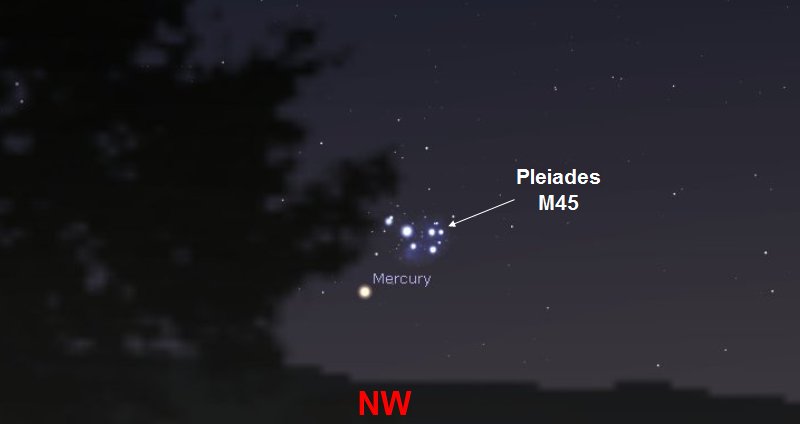 |
| |
|
Mercury is the smallest planet in our Solar
System - only slightly larger than our Moon. Because it is so close to the
Sun and it orbits so fast, a year on the planet only lasts 88 days. We are
further away so our year lasts 365 days. |
| |
|
If you are observing the planet, you are
looking at a place where the surface temperature varies from -173 degrees
Celsius at night to +427 degrees during the day because it has no atmosphere
to protect the planet and act as a blanket! To make matters worse, Mercury
spins very slowly on its axis and a day on Mercury lasts 59 earth days, so
if you were visiting, you'd be alternately frozen and cooked for long
periods of time! |
| |
|
Confusingly, Mercury is not the hottest
planet in the Solar System - that title goes to Venus because its thick
atmosphere traps heat! |
|
Monday 18th to
Sunday 24th April 2022 |
| |
|
The evening of Friday 22nd sees the peak of
the Lyrid meteor shower. The radiant point where the meteors appear to
originate from is slightly above and to the right of the constellation of
Lyra. After dark, the constellation will be towards the north east and as
we proceed through the night, it climbs higher in the sky. |
| |
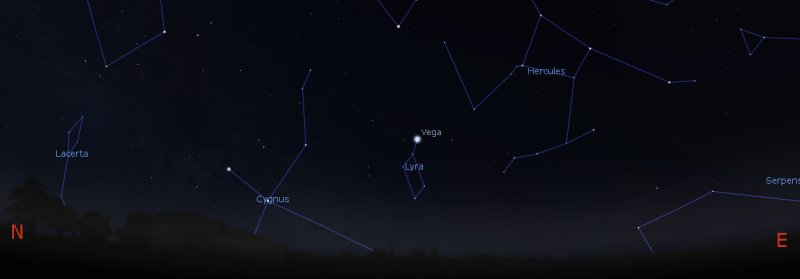 |
| |
|
The Moon does not rise above the horizon
until 4am on the Saturday morning, so it won't be producing any light
pollution to spoil your view of the shooting stars that are the debris from
comet Thatcher. |
| |
|
Nobody in current times has seen the actual
comet. Your children will never see it either as comet Thatcher takes 417
years to orbit around the Sun and it's currently 107 Astronomical Units away
which is 107 times further away from the Sun than we are. In 45 years the
comet will be at its furthest point from the Sun, to use the correct term,
at Apogee and will then begin a slow return towards the centre of our Solar
System! |
| |
|
An interesting event occurs around 5am on the
morning of Sunday 24th. If you look to the east, you will see four of our
neighbouring planets forming a straight diagonal line - from left to right -
Jupiter, Venus, Mars and Saturn with a Last Quarter Moon thrown in for good
measure to the right of that! |
| |
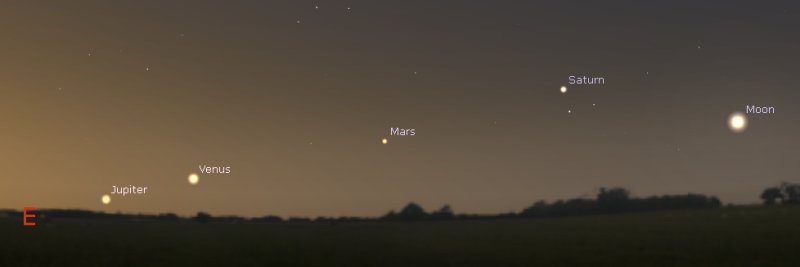 |
| |
|
Please don't be tempted to use a telescope or
binoculars to obtain a better view as the Sun will be rising and you must
never catch even a glimpse of the Sun through a telescope as it will cause
instant and permanent blindness! |
|
Monday 11th to
Sunday 17th April 2022 |
| |
|
There's nothing particularly special
happening on the astronomy front next week, but Saturday 16th brings a Full
Moon, easy to spot after dark towards the south east. If you are looking
for faint deep sky objects with your telescope, this is the worst possible
time as the Moon will be very bright and the sunlight reflecting from it
creates the ultimate light pollution. |
| |
|
On the other hand, it is a great opportunity
to observe some of the lunar features, especially the large dark flat areas
that early astronomers used to think were seas or oceans. Of course we now
know that these "mare", derived from the Latin word for "sea", are really
large basaltic plains, created by ancient asteroid impacts. |
| |
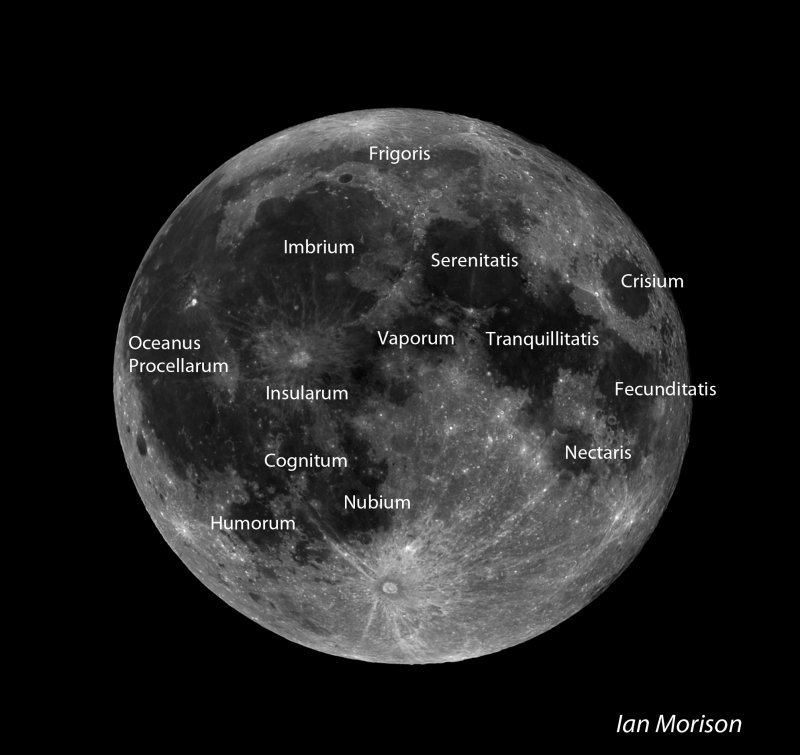 |
| |
|
They cover approximately 16% of the lunar
surface facing us and appear dark because of their iron-rich composition.
Curiously, there are only a few small mare on the dark side of the Moon that
is always facing away from us. |
| |
|
The mare are easy to identify with the naked
eye, but if you fancy a bit more of a challenge you could have a go at
locating some of the lunar craters that were formed by smaller impacts. The
Moon has 9,137 of them in total! The most obvious crater towards the south
of the Moon is called Tycho. It is a relatively young crater, estimated to
be only 108 million years old! Stretching away from Tycho is a prominent
ray system and you can almost imagine the object that created the crater
going "splat" as it hit! |
| |
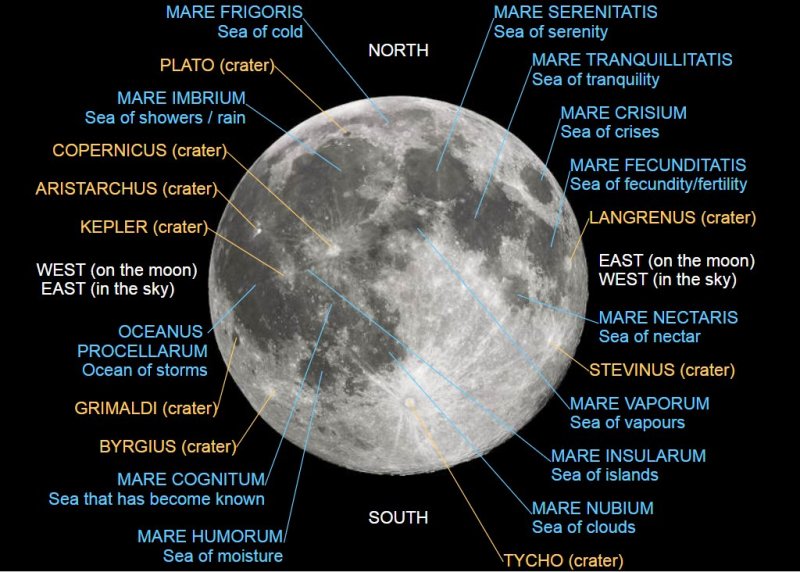 |
| |
|
Image courtesy of Wikipedia |
|
Monday 4th to
Sunday 10th April 2022 |
| |
|
Back in February, I mentioned an open star
cluster called Melotte 111 that is located in the constellation of Coma
Berenices, between the constellations of Bootes and Leo. It is visible in
the late evening towards the south east and the month of April is an ideal
time as Coma Berenices reaches its highest point in the night sky. |
| |
|
To the left of Melotte 111 is an area of sky
originally given the wonderful-sounding name "The Realm of Galaxies". It is
now more-commonly known as the Coma Galaxy Cluster. |
| |
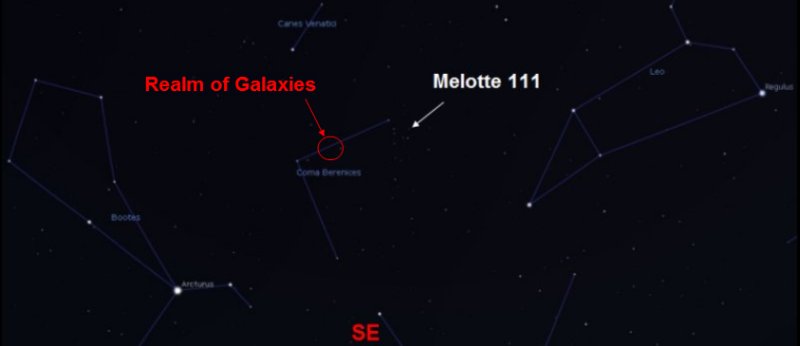 |
| |
|
The centre of the cluster is some 320 million
light years away from us and the galaxies in it are moving away from us at a
speed of 15 million miles per hour. |
| |
|
A dark sky location and medium-size telescope
will enable you to see some of the 10,000 galaxies located in that area.
There is a mixture of spiral galaxies like our own Milky Way and elliptical
galaxies that are formed when two galaxies merge together. The galaxies are
listed in catalogues such as the NGC "New General Catalogue" and IC "Index
catalogue" rather than the more familiar Messier Catalogue as Charles
Messier didn't discover them! |
| |
|
The American astronomer Edwin Hubble studied
galaxies in depth and came up with a classification system for all the
different types. I have included a copy of what is known as his "Tuning
Fork" diagram. Our Milky Way is actually a barred spiral galaxy which is
given a Hubble classification of SB. |
| |
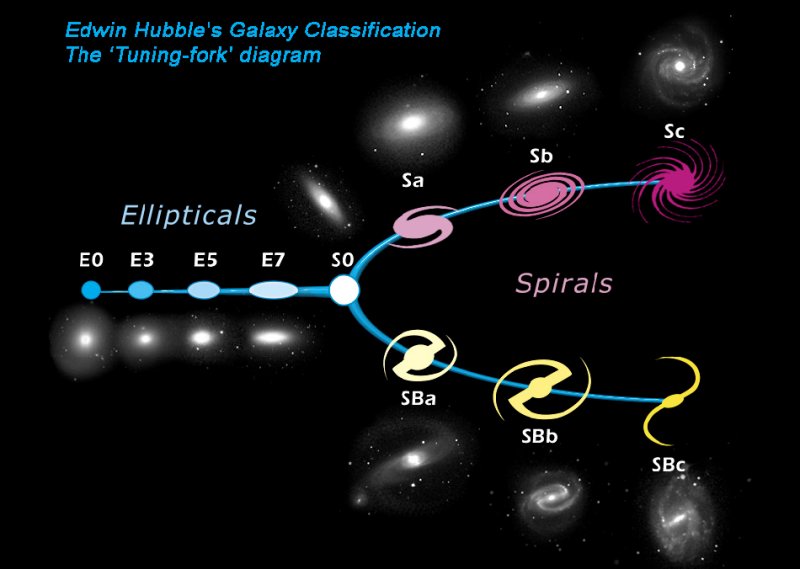 |
| |
|
If Hubble's name sounds familiar - that's
because the Hubble Space Telescope was named in his honour. |






